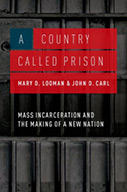A Country Called Prison

Authors: Mary D. Looman and John D. Carl
Publisher: New York: Oxford University Press, 2015. 232p.
Reviewer: Steven Block | March 2016
The crime control approach of the 1980s and 1990s resulted in a well-documented rise in the U.S. prison population that would not plateau until early in the 21st century. By the year 2000, the incarceration rate in the country had tripled from its levels around 1980. Books published within the last decade have examined the implications of this increase in the United States from criminological, sociological, and psychological perspectives. In their new book, A Country Called Prison, authors Mary D. Looman and John D. Carl contribute to this ongoing dialogue by framing the harms of incarceration in an innovative context using the analogy of the U.S. prison system as a country.
Both co-authors, Looman and Carl, have years of experience working directly with correctional populations in addition to their educational backgrounds. In their writing, the authors apply an approach that mixes anecdotes from these experiences in correctional facilities, with criminology theory and statistical support. The result is a book that reads smoothly and challenges the reader’s viewpoints, while introducing both narrow and broad policy recommendations for the future.
In the first two chapters, the authors set out to establish that the United States uses prison in a manner that is far different from any other industrialized nation. To make this point, data are provided on incarceration rates, as well as estimates of the U.S. prison population living under some form of correctional supervision or with a criminal record. Additionally, evidence is given to show that this reliance on incarceration has impacted certain groups of people more than others. While the authors do not intend to provide a comprehensive historical examination of all the roots of contemporary incarceration practices, key turning points are briefly documented. These major historical events include the rise of the Progressives, the deinstitutionalization of the mentally ill, the publication of Robert Martinson’s views questioning the effectiveness of rehabilitation, and the political support for the War on Drugs.
The authors then embark on an effort to draw the connections for their primary thesis that links the U.S. prison system to the attributes of a country. In Chapter 2, the authors present several qualities that define a nation, including maintaining a substantial population and sharing common history, identity, language, values, and an economic system. While some readers may initially feel that the description of a prison as a country is hyperbole, a strong case is developed using data, theory, pop culture, and references to personal experiences. By the conclusion of the second chapter, readers will have little choice but to admit that there are numerous characteristics present in our prisons that are also found in our definitions of a nation.
The next three chapters (Chapters 3-5) target specific components of the incarceration dilemma by focusing on the individuals who live in prison, the culture of prisons, and challenges in prisoner release. One of the critical assumptions in these chapters is that prison inmates can be divided into different categories. On one hand, there are a small number of prisoners whose imprisonment is completely justified based on their heinous, dangerous actions. These are the individuals whom society fears. Conversely, the authors assert that a substantial percentage of prison inmates do not frighten the public. Rather, most prisoners have committed acts that society wishes to restrict, yet the people who commit such actions do not necessarily scare us. Another topic that the authors consider crucially important for understanding prison life is the complex relationships between staff and guards. Relying on research in psychology, it is argued that day-to-day decisions in prison are often made without careful consideration of the true objectives and goals of the institution.
These chapters also contain proposals for change at the conclusion of each chapter. Among the most practical and innovative solutions include an adaptation to technological changes, with more of an educational focus on computer-based learning and separately, more consideration in mixing populations within correctional institutions. Other suggestions involve placing more attention and funding toward facilitating a successful re-entry process at the point of release.
The final two chapters contain further recommendations for reform. The primary focus of Chapter 6 is on more wide-ranging changes that could alter the country’s reliance on incarceration. Some of these recommendations, such as the role of jury nullification and an overall reduction in crime, are generally beyond the scope of the book and only covered in brief. In other instances, the authors provide direct recommendations for prison reform. Perhaps the most thought provoking policy recommendation is the focus on shifting costs of incarceration to the local level. The authors’ argument is that the public and local officials would be more hesitant to rely on incarceration if a stronger connection existed between local taxpayers and the costs of local imprisonment. Currently, the public may not realize that there are substantial costs associated with mass incarceration, or they may believe that other people are paying for it.
For students and scholars of punishment, the introductory content documenting the overuse of incarceration in the United States will provide a summary of the issues facing the country in this area. The key addition to the literature base on American prisons occurs in the subsequent pages, particularly in Chapter 2. The authors’ claim that U.S. prisons are analogous to political entities is supported by the sheer size of correctional populations and many other characteristics, such as culture and methods of communication. These connections are made thoroughly and thoughtfully.
After the publication of dozens of articles and books targeting incarceration in the United States, it may seem that there are no angles of this topic left to uncover. To the contrary, this book from Looman and Carl demonstrates that there are perspectives yet to be articulated. One would hope that other authors will follow their lead in continuing to search for creative ways to express the detrimental impact of hyper-incarceration in America.
Steven Block, PhD, Assistant Professor of Criminology and Criminal Justice, Central Connecticut State University


